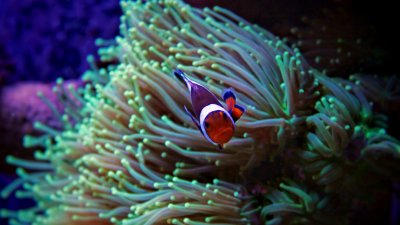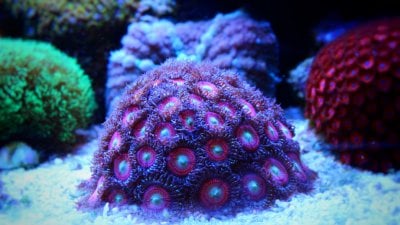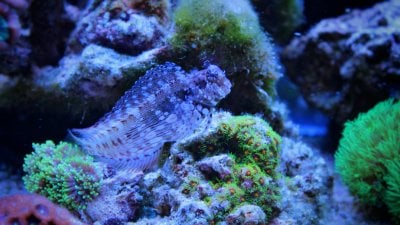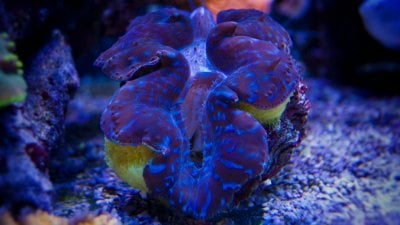Everything is getting smaller. Laptops are thinner, lighter and overtly smaller than ever. Our phone’s screens sometimes get bigger, but their overall body shrinks in size. The X-Box slim is simply a smaller version of the X-Box One, with enhanced performance features. While marine aquariums were once massive systems that needed dedicated rooms to function, they too are shrinking in size. We have all-in-one tanks, that consolidate a tank’s various peripherals into a neat, compact filter compartment. Of course, there is also the revolution in nano-tanks, something that wouldn’t have been predicted 15 years ago, when it was believed a high volume of water was needed to maintain a marine tank.
The nano-revolution has changed marine aquaria so much, that first time aquarists have been investing in nano-tanks for quite some time now. I even know some aquarists who made a pico-tank (around 1-5 gallons in size) their first marine system. Currently trendy jellyfish tanks range for 3-6 gallons in size and some aquarists are retro-fitting the kressil (circular, gyroscopic) jellyfish design to serve other reef purposes. No matter how you view it, nano-aquariums have changed marine aquaria. Much like Apple changed computers, with the release of the iMac. With the iMac, multiple components of modern computing where all compacted into one shell which easily fit on most desktops. Gone were multiple components like monitors, towers, speakers, etc. However, like the iMac, nano-aquaria comes with a host of limitations. Ever try putting an upgraded video card in an iMac, well the same applies when trying to place an over-sized protein skimmer in a nano-system.
Given the popularity of nano-systems, are they really appropriate for new marine aquarists or is the traditional marine aquarium a better approach.
Then and now:
When I entered marine aquaria 20 years ago, there was no such thing as a nano-reef. A traditional reef alone was hard to find in western Maryland and the only shop that carried reef keeping supplies close to my home only offered a 55-gallon aquarium as part of a “reef package.” Anything smaller, I was told, would lead to fluctuating water chemistry and eventually, the demise of the tank’s inhabitants. Yet, I was an obnoxious young man with a limited budget who cared little for established rules. I wanted to breed percula clownfish and didn’t see why in the world I needed 55 gallons to do it in.
With that I took an empty 20-gallon long aquarium, loaded it with live rock and two powerheads, slapped a simple hang on back (HOB) power filter to it and my first marine aquarium was born. I simply took black sharpie to mark the water line when the tank was full and kept a reservoir of freshwater nearby. Each day, I would replace the evaporated water. In less than a year, I was nursing baby clownfish.
Today, such an approach is hardly revolutionary. Most clownfish breeders use networks of small tanks to house their brood stock, but 20 years ago the thought of such a small marine system was outlandish. For one, we didn’t know nearly as much about how marine life would handle captivity. There was this belief that marine fish collected from the wild were so delicate and sensitive that a shift of a few points salinity would certainly kill them. There was also this belief that no novice fish keeper would be attentive enough to monitor a tank correctly for evaporation.
To make matters worse, the equipment that generated current back then was massive, usually requiring multiple large power heads connected to circulating timers. Filtration equipment too was large, with external wet/dry filters being the weapon of choice in those days. Halide lighting could cook nano-aquaria water and protein skimmers were in their infancy. Most were long, slender tubes powered by only a lime wood air stone. In short, aquarists and the industry had a lot to learn. Fears about water chemistry changes and their effect on fish and corals led to the belief that frequent partial water changes were bad. In order to compensate, the tank needed to be large and sparsely populated so water changes only needed performed every month or so.
When I first starting keeping corals, I was sure to have two separate tanks, one for fish and one for corals. The thought of mixing the two seemed impossible, simply because no way to mitigate waste existed.
Over time we learned that while marine fish are sensitive to water chemistry fluctuations, they aren’t nearly as sensitive as we once thought. In fact, fluctuation of salinity due to evaporations wasn’t near enough to upset the balance of a marine aquarium unless it was severely neglected. Bacterial stains could be encouraged to colonize live rock that could assimilate nitrate, meaning that fish could in fact live with corals. Also, if you mixed marine water to the right parameters, partial water changes could be conducted on a regular basis.
Technology arose that could automatically replenish evaporating water and monitor the tank for instability. Depending on the pump and design, an efficient protein skimmer didn’t need to be massive. Some coral species tolerated residual waste in the water and preferred it. As a result, marine aquariums got smaller.
It’s been a number of years since JBJ released the original nano-cube. When first released, many aquarists scoffed at the idea of a small, all-in-one marine aquarium. Yet, the idea surged in popularity and now nearly every major aquarium producer has their own version of JBJ’s original design. Now, they are even marketed and sold to beginners and many aquarists become addicted to the hobby via a 12-gallon box of water.
Are they appropriate for beginners?
People have a myriad of goals when setting up a marine aquarium for the first time. I am not sure anyone sets out to pack rooms full of hundreds of gallons of seawater, the first time they walk into a marine aquarium shop. Often, it’s common curiosity that leads to a person’s first marine tank. Years ago, the sheer size of marine aquariums and all their related equipment turned off many would be aquarists. It totally relegated entire segments of society away from keeping a tank. College students often didn’t have the space or funds to set-up a fully equipped marine aquarium, before the rise of nano-tanks. Most people didn’t want to invest an entire segment of their home to an aquarium either. Anyone with limited space was out of luck, especially if a fish shop would only sell you a 55 gallon (or larger) tank to start with.
Nano-marine aquaria changed all of that. Nano tanks are far less intimidating and while all-in-one set-ups run at a premium price when compared to traditional tanks, the overall cost to implement one pales in comparison. It’s without a doubt that the rise of nano-reef aquaria has led to the expansion of the hobby, turning what was once a small, almost fringe segment of aquarists who kept reef tanks, into a full bodied hobby and potent income generator.
The issue with nano-aquaria, at least in the beginning, is that water chemistry, overcrowding and species suitability issues are condensed and magnified when keeping small volumes of marine water. Often, nano-reef keepers are tempted to buy juvenile fish that aren’t suitable for a small tank. Aquarium manufacturers don’t help, when they release advertisements showing 18-30 gallon tanks housing surgeonfish. These fish grow quickly, become stressed by the confines of the tank and eventually contribute to overall deteriorating health within the aquarium. Stressed fish are often most susceptible to disease, which can spread to otherwise healthy tank mates. It’s been well documented that smaller volumes of water experience significant water chemistry swings due to evaporation. A good auto-top-off system can minimize this, but is also tricky to implement on small, sump-free aquariums. Once you add a top-off reservoir, the neat and tidy feel of a nano-reef is quickly lost.
Lighting can be a challenge in nano-aquaria. Some nano-tanks come with pre-selected lighting, but reviews are mixed on how well it performs and complaints have been made claiming it only allows the aquarist to keep a small percentage of coral species. Over-illumination can be a problem, since nano-tanks are inevitably shallow with little room to naturally block intense light. On the flip-side, it’s much cheaper to light a nano-tank, since they often don’t require the sheer number of high output lights a large reef aquarium does.
Coral selection for nano-aquaria is also a challenge. Many easily kept, beautiful but large and aggressive coral species grow too quickly and too large, to be considered appropriate for nano-aquaria. Euphyllia corals, a favorite among novice reefers, have sweeper tentacles that can cover a large swath of nano-aquaria, stinging everything in their path. Even a beginning nano-aquarist has to be creative and smart, moving forward with a good foundation on the basics of reef keeping and aqua scaping.
Luckily all of these issues can be overcome, by putting some research into tank set-up beforehand. Easy to use PAR meters are becoming ambiguities throughout the hobby and can greatly aid nano-reefers in determining appropriate lighting, coral placement and aqua-scaping. All of the issues a nano-reef presents are also presented in large aquariums, just not nearly as condensed, so a good aquarist will need to be aware of them, regardless of system size. While the room for error is greater with a nano-reef, it can also be a good tool to introduce someone to reef aquaria, without placing lots and lots of animals under their care or risking a huge financial loss.
Equipment selection for nano-tanks is streamlined when compared to shopping for large tank equipment. The past few years have led to some efficient, affordable and easy to implement nano-reef technology, which is 100% plug and play. For a beginning aquarist, this means that equipment options are easily spelled out and not confusing to properly set-up. Tunze, Innovative Marine, Skimz and Reef Octopus are manufacture quality nano-reef skimmers, which are compact and simple. All in all, a successful nano-reef requires the same investment of time, patience and research that a traditional reef aquarium does and in that, they are equally as suitable for beginners.
A bridge too bigger and “better” things:
For new aquarists considering a nano-reef, it’s important to understand that nano-tanks can be just as awe-inspiring as large, full service aquariums. In fact, some of nano-reefing’s limitations allow nano-reefers to concentrate on aspects of reef keeping lost in the shuffle of keeping a large tank. I’ve seen delicately aqua-scaped nano-reefs that could rival the sheer mass of a large aquarium. Nano-aquaria really is its own sub-set of overall reef aquaria and one that has a promising future and an incredible presence.
Nano-reefs can truly capture the “Zen” of reef aquaria, with un-cluttered designs and minimalistic tones that highlight the natural beauty of fish and corals. They are picturesque, yet minute windows into the aquatic world that are easy to appreciate and thanks to new technology, set-up and maintain.
DISCUSS THIS ARTICLE HERE
The nano-revolution has changed marine aquaria so much, that first time aquarists have been investing in nano-tanks for quite some time now. I even know some aquarists who made a pico-tank (around 1-5 gallons in size) their first marine system. Currently trendy jellyfish tanks range for 3-6 gallons in size and some aquarists are retro-fitting the kressil (circular, gyroscopic) jellyfish design to serve other reef purposes. No matter how you view it, nano-aquariums have changed marine aquaria. Much like Apple changed computers, with the release of the iMac. With the iMac, multiple components of modern computing where all compacted into one shell which easily fit on most desktops. Gone were multiple components like monitors, towers, speakers, etc. However, like the iMac, nano-aquaria comes with a host of limitations. Ever try putting an upgraded video card in an iMac, well the same applies when trying to place an over-sized protein skimmer in a nano-system.
Given the popularity of nano-systems, are they really appropriate for new marine aquarists or is the traditional marine aquarium a better approach.
Then and now:
When I entered marine aquaria 20 years ago, there was no such thing as a nano-reef. A traditional reef alone was hard to find in western Maryland and the only shop that carried reef keeping supplies close to my home only offered a 55-gallon aquarium as part of a “reef package.” Anything smaller, I was told, would lead to fluctuating water chemistry and eventually, the demise of the tank’s inhabitants. Yet, I was an obnoxious young man with a limited budget who cared little for established rules. I wanted to breed percula clownfish and didn’t see why in the world I needed 55 gallons to do it in.
With that I took an empty 20-gallon long aquarium, loaded it with live rock and two powerheads, slapped a simple hang on back (HOB) power filter to it and my first marine aquarium was born. I simply took black sharpie to mark the water line when the tank was full and kept a reservoir of freshwater nearby. Each day, I would replace the evaporated water. In less than a year, I was nursing baby clownfish.
Today, such an approach is hardly revolutionary. Most clownfish breeders use networks of small tanks to house their brood stock, but 20 years ago the thought of such a small marine system was outlandish. For one, we didn’t know nearly as much about how marine life would handle captivity. There was this belief that marine fish collected from the wild were so delicate and sensitive that a shift of a few points salinity would certainly kill them. There was also this belief that no novice fish keeper would be attentive enough to monitor a tank correctly for evaporation.
To make matters worse, the equipment that generated current back then was massive, usually requiring multiple large power heads connected to circulating timers. Filtration equipment too was large, with external wet/dry filters being the weapon of choice in those days. Halide lighting could cook nano-aquaria water and protein skimmers were in their infancy. Most were long, slender tubes powered by only a lime wood air stone. In short, aquarists and the industry had a lot to learn. Fears about water chemistry changes and their effect on fish and corals led to the belief that frequent partial water changes were bad. In order to compensate, the tank needed to be large and sparsely populated so water changes only needed performed every month or so.
When I first starting keeping corals, I was sure to have two separate tanks, one for fish and one for corals. The thought of mixing the two seemed impossible, simply because no way to mitigate waste existed.
Over time we learned that while marine fish are sensitive to water chemistry fluctuations, they aren’t nearly as sensitive as we once thought. In fact, fluctuation of salinity due to evaporations wasn’t near enough to upset the balance of a marine aquarium unless it was severely neglected. Bacterial stains could be encouraged to colonize live rock that could assimilate nitrate, meaning that fish could in fact live with corals. Also, if you mixed marine water to the right parameters, partial water changes could be conducted on a regular basis.
Technology arose that could automatically replenish evaporating water and monitor the tank for instability. Depending on the pump and design, an efficient protein skimmer didn’t need to be massive. Some coral species tolerated residual waste in the water and preferred it. As a result, marine aquariums got smaller.
It’s been a number of years since JBJ released the original nano-cube. When first released, many aquarists scoffed at the idea of a small, all-in-one marine aquarium. Yet, the idea surged in popularity and now nearly every major aquarium producer has their own version of JBJ’s original design. Now, they are even marketed and sold to beginners and many aquarists become addicted to the hobby via a 12-gallon box of water.
Are they appropriate for beginners?
People have a myriad of goals when setting up a marine aquarium for the first time. I am not sure anyone sets out to pack rooms full of hundreds of gallons of seawater, the first time they walk into a marine aquarium shop. Often, it’s common curiosity that leads to a person’s first marine tank. Years ago, the sheer size of marine aquariums and all their related equipment turned off many would be aquarists. It totally relegated entire segments of society away from keeping a tank. College students often didn’t have the space or funds to set-up a fully equipped marine aquarium, before the rise of nano-tanks. Most people didn’t want to invest an entire segment of their home to an aquarium either. Anyone with limited space was out of luck, especially if a fish shop would only sell you a 55 gallon (or larger) tank to start with.
Nano-marine aquaria changed all of that. Nano tanks are far less intimidating and while all-in-one set-ups run at a premium price when compared to traditional tanks, the overall cost to implement one pales in comparison. It’s without a doubt that the rise of nano-reef aquaria has led to the expansion of the hobby, turning what was once a small, almost fringe segment of aquarists who kept reef tanks, into a full bodied hobby and potent income generator.
The issue with nano-aquaria, at least in the beginning, is that water chemistry, overcrowding and species suitability issues are condensed and magnified when keeping small volumes of marine water. Often, nano-reef keepers are tempted to buy juvenile fish that aren’t suitable for a small tank. Aquarium manufacturers don’t help, when they release advertisements showing 18-30 gallon tanks housing surgeonfish. These fish grow quickly, become stressed by the confines of the tank and eventually contribute to overall deteriorating health within the aquarium. Stressed fish are often most susceptible to disease, which can spread to otherwise healthy tank mates. It’s been well documented that smaller volumes of water experience significant water chemistry swings due to evaporation. A good auto-top-off system can minimize this, but is also tricky to implement on small, sump-free aquariums. Once you add a top-off reservoir, the neat and tidy feel of a nano-reef is quickly lost.
Lighting can be a challenge in nano-aquaria. Some nano-tanks come with pre-selected lighting, but reviews are mixed on how well it performs and complaints have been made claiming it only allows the aquarist to keep a small percentage of coral species. Over-illumination can be a problem, since nano-tanks are inevitably shallow with little room to naturally block intense light. On the flip-side, it’s much cheaper to light a nano-tank, since they often don’t require the sheer number of high output lights a large reef aquarium does.
Coral selection for nano-aquaria is also a challenge. Many easily kept, beautiful but large and aggressive coral species grow too quickly and too large, to be considered appropriate for nano-aquaria. Euphyllia corals, a favorite among novice reefers, have sweeper tentacles that can cover a large swath of nano-aquaria, stinging everything in their path. Even a beginning nano-aquarist has to be creative and smart, moving forward with a good foundation on the basics of reef keeping and aqua scaping.
Luckily all of these issues can be overcome, by putting some research into tank set-up beforehand. Easy to use PAR meters are becoming ambiguities throughout the hobby and can greatly aid nano-reefers in determining appropriate lighting, coral placement and aqua-scaping. All of the issues a nano-reef presents are also presented in large aquariums, just not nearly as condensed, so a good aquarist will need to be aware of them, regardless of system size. While the room for error is greater with a nano-reef, it can also be a good tool to introduce someone to reef aquaria, without placing lots and lots of animals under their care or risking a huge financial loss.
Equipment selection for nano-tanks is streamlined when compared to shopping for large tank equipment. The past few years have led to some efficient, affordable and easy to implement nano-reef technology, which is 100% plug and play. For a beginning aquarist, this means that equipment options are easily spelled out and not confusing to properly set-up. Tunze, Innovative Marine, Skimz and Reef Octopus are manufacture quality nano-reef skimmers, which are compact and simple. All in all, a successful nano-reef requires the same investment of time, patience and research that a traditional reef aquarium does and in that, they are equally as suitable for beginners.
A bridge too bigger and “better” things:
For new aquarists considering a nano-reef, it’s important to understand that nano-tanks can be just as awe-inspiring as large, full service aquariums. In fact, some of nano-reefing’s limitations allow nano-reefers to concentrate on aspects of reef keeping lost in the shuffle of keeping a large tank. I’ve seen delicately aqua-scaped nano-reefs that could rival the sheer mass of a large aquarium. Nano-aquaria really is its own sub-set of overall reef aquaria and one that has a promising future and an incredible presence.
Nano-reefs can truly capture the “Zen” of reef aquaria, with un-cluttered designs and minimalistic tones that highlight the natural beauty of fish and corals. They are picturesque, yet minute windows into the aquatic world that are easy to appreciate and thanks to new technology, set-up and maintain.
DISCUSS THIS ARTICLE HERE


















